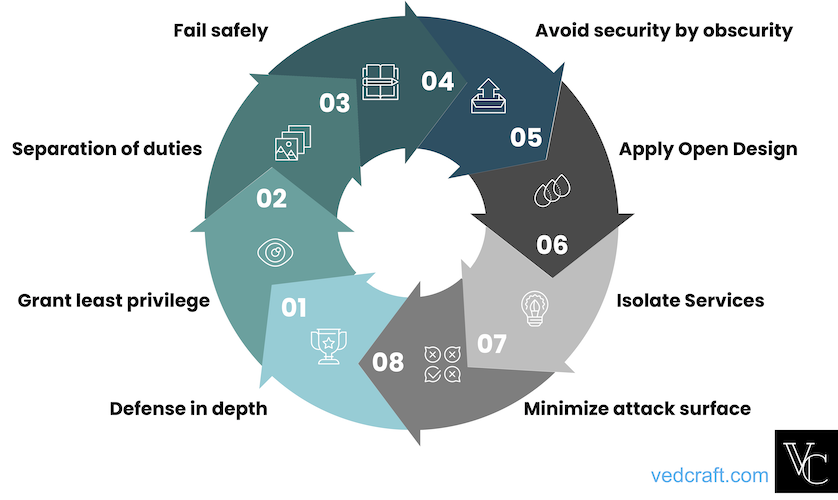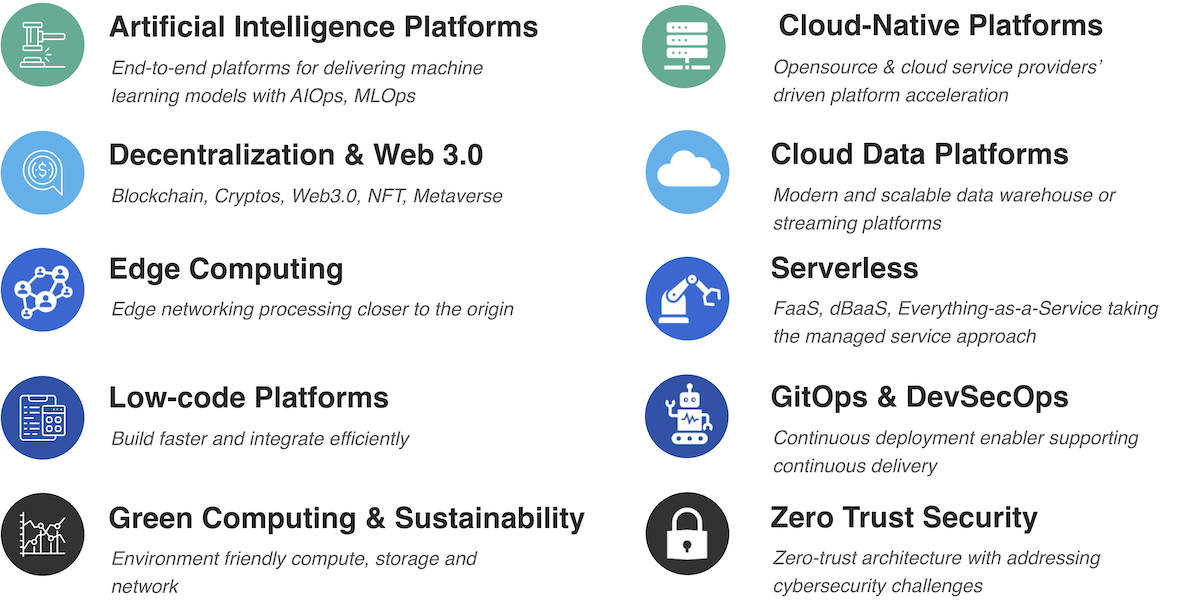Observing technology trends by analysts, research companies, and thought leaders provides a broader perspective. It not only helps software architects to understand the impact of technologies being adopted but also helps them build the right skill-set for themselves or their team. This article synthesizes the top ten technology trends for 2022 and beyond based on broader research.
#1 — Artificial Intelligence Platforms
- Artificial Intelligence and Machine Learning have reached mainstream adoption and the next wave is to automate associated operations.
- AI engineering practices will be a differentiator with practices such as AIOps, MLOps, DataOps — extending the DevOps culture to Artificial Intelligence.
- Companies will either custom-build AI Platforms using Cloud-native services or use AI Platforms such as Dataiku, Amazon Sagemaker, Azure AI, Google Vertex AI, DataRobot, IBM Watson, H2O.ai, and many more.
- AI will continue to get democratized and be more accessible to the wider community — not just data scientists but also to application architects, solution architects, developers, business architects, and product managers.
Forrester predicts that The AI Software Market Will Grow To $37 Billion Globally By 2025.
#2 — Cloud-Native Platforms
- The lift-and-shift cloud migrations have been the initial strategy but the long-term strategic objective is to use Cloud-native services to leverage advantages of scalability, availability, and cost-effectiveness of the Cloud.
- Companies will either build their own platform with cloud-native technologies or customize pre-built platforms to accelerate their journey.
- Opensource cloud-native technologies are redefining the innovation ecosystem and a community like CNCF is fostering open-source and vendor-neutral technologies.
Gartner predicts that by 2025, cloud-native platforms will serve 95% of new digital initiatives —steep rise from 40% in 2021.
#3 — Decentralization & Web 3.0
With distributed computing as the foundational building block of the cloud, decentralization will continue to be extended further with new technologies centered around the Blockchain ecosystem. While there is a hype around Web3.0, there will be momentum starting in 2022 at least from an experimentation perspective, and in coming years, it will start getting considered for production systems. Key aspects are:
- Decentralization with Web 3.0 (the term was coined by Ethereum co-founder Gavin Wood in 2014) will continue to gain popularity largely because of cryptocurrencies.
- Not only financial solutions but also solutions like smart cities will run on the blockchain while there is sustainability (green compute) concerns around it.
- NFT (Non-fungible Token) is already gaining momentum and made a business of $23B in 2021 rising 7X from 2020 (reference report).
- Metaverse — With focus by tech giants (e.g. Facebook Meta and Microsoft), it will continue to rise further, which has multiple elements of technology, including virtual reality and augmented reality creating the virtual universe. Metaverse uses decentralization and Web 3.0 technologies such as Blockchain.
Twitter has already started an initiative, Bluesky, to build a social web using a decentralized network (Web 3.0).
#4 — Serverless
- Serverless compute and storage has gained mainstream adoption and 2022 will continue to support this trend with increasing cloud adoption
- Serverless will continue to offerings such as — Function-as-a-Service, Backend-as-a-Service, Database-as-a-Service, Storage-as-a-Service, Kubernetes or Container Orchestration-as-a-Service, and many more.
- Similar to 2021, this year will continue to see new launches such as — AWS extended SAM platform (new capabilities like SAM Accelerate), Azure extending its Servlerss platform, and Cloudflare extending Servless capabilities like Workers and Pages for JAMStack.
- Not only key cloud service providers (AWS, Azure & Google Cloud) are driving the adoption, but also new players are going to get market share as they are simplifying Serverless adoption. Interestingly, most of these players might be using cloud service providers behind the scenes or allowing end-users to choose the provider by adding the abstraction layer on top of the providers.
Key examples of new launches in 2021 are:
- Akka Serverless (launched in June 2021) — to build real-time applications using managed Serverless platform.
- MongoDB Realm (launched in June 2021) — to build apps powered by MongoDB database as an integrated platform.
Opensource solutions also continue to make their mark in Serverless with platforms to avoid vendor lock-in:
- Apache Openwhisk — an open-source, distributed Serverless platform that executes functions (fx) in response to events at any scale.
- Knative — Kubernetes-based platform to deploy and manage modern serverless workloads.
- Others: OpenFaaS, Kubeless, Project Riff, IronFunctions, etc.
Gartner has predicted that global cloud spending will increase up to $480B by 2022 (Source: Gartner)
#5 — Zero Trust Security
- With growing concerns over Cyberattacks, Zero Trust security will continue to be the key focus area with cloud adoption in 2022. Click here to read more about the principles outlined by Microsoft.
- Cloud Security has also enabled a new era of innovative solutions by new players and startups partnering with cloud vendors to offer innovative solutions. Some examples are Armor for Cybersecurity,
- Click here to read a detailed article on Security practices for awareness.

By 2022, 80% of new digital business applications opened up to ecosystem partners will be accessed through zero-trust network access (ZTNA). By 2023, 60% of enterprises will phase out most of their remote access virtual private networks in favor of ZTA.(Source: Gartner)
#6 — GitOps & DevSecOps
- As DevOps is in the maturity stage of adoption, DevOps practices will continue to get extended in 2022 for areas like Security, Machine Learning, Artificial Intelligence, and Continuous Delivery.
- GitOps (since its inception in 2017 by Weaveworks) is gaining mainstream adoption and 2022 will put it into the focus for many organizations in their technology roadmap. While opensource solutions like Argo CD (GitOps for Kubernetes), JenkinsX (for automating CD pipeline), and Flux (providing a family of GitOps projects) will continue to get adopted, established players will launch similar capabilities (example — GitHub Actions).
- DevSecOps is promoting the shift-left strategy to detect security vulnerabilities early in the development stage and will continue to be in mainstream adoption.
- Other interesting trends are MLOps and DataOps, which are extending DevOps concepts to Machine Learning and Data respectively.
GitOps is an operational framework that takes DevOps best practices used for application development such as version control, collaboration, compliance, and CI/CD, and applies them to infrastructure automation.
(Source: Gitlab)
#7 — Cloud Data Platforms
- The rise of Snowflake as a modern cloud data platform has triggered a new wave of innovation and changed the perception of storing data in the cloud. Nowadays financial services organizations have started using similar platforms or started considering it and this trend will continue to foster in 2022.
- Other players have also gained momentum in adoption as a Cloud Data Platform such as Databricks, AWS Redshift, Cloudera, Google Cloud BigQuery, and the list goes on.
- Another interesting trend is the integrated offering of these platforms — Artificial Intelligence Services + Data Platform and Mobile or Web Apps + Data Platform, which will continue to be the trend in 2022 and beyond.
Customer Data Platform Market Rising at a CAGR of 24.5% to Reach USD 4,364.7 Million by 2027.
(Source: Fortune Business Insights)
#8— Edge Computing
- With new or upcoming ultra-fast networks like 5G and Wi-Fi 6E, edge computing will continue to rise further in 2022.
- Smart devices are predicted to be quadrupled by 2025 providing impetus to focus on edge computing for the Internet of Things (IoT).
- Kubernetes-at-edge will continue to thrive in 2022 with frameworks such as Akri, and KubeEdge as announced in Edge Conference in 2021.
- Primary cloud vendors (AWS, Azure, Google Cloud) will continue to enhance capabilities for Edge Cloud — AWS for the Edge, Google Distributed Cloud for Edge (announced in Google Next ‘21), and Azure private edge compute.
The total edge computing addressable market will grow to US$543 billion in 2030 at a CAGR of 49% over the 10-year period.
(Source: STL Partners)
#9 — Low-code Platforms
Low-code platforms have gained momentum not only for small companies or startups but also for medium and large enterprises considering the efficiencies and time-to-market. This will remain the technology focus area in near future enabling organizations to launch capabilities faster with cost-efficiency and skillset to be watched for.
The spectrum of vendors offering low-code platforms is ranging from seasoned players to new and niche players providing a visual interface, out-of-the-box connectors, and marketplace for business applications. They can be categorized as:
- Enterprise low-code platforms: With a more readymade ecosystem for building apps such as Mendix, Microsoft Power Apps, Oracle APEX, OutSystems, Pega Infinity, Salesforce, ServiceNow, and more.
- Cloud service providers: There are cloud-native services to build business apps using Azure App Service, AWS Amplify, or Google Firebase. Additionally, Azure Power Apps, Google Cloud AppSheet, and AWS Honeycode provide a low-code-focused development ecosystem as well.
- Niche platforms: Specific players focusing on specialized areas such as Creatio, Zoho, Kintone, Newgen, and Quickbase.
Forrester research predicts a 15% rise in the low-code market in 2022.
#10 — Green Computing & Sustainability
Sustainability considering environmental concerns will rise as a key facet to be considering when designing hyperscale architecture. AWS has announced in 2021 to include Sustainability as an architectural pillar indicates the trend towards a focus on green computing.
To extend the above list further, these are also the trends to watch for:
- Hybrid & Multi-Cloud
- Quantum Computing
- Internet of Things
- High-performance Computing
- Space technology
- Software-defined Network
- Generative AI
- Robotics
- Privacy Enhanced Computation
- AI-assisted Software Development
To conclude, these are the key top technology trends for 2022 and beyond, which will continue to evolve with new architecture and design patterns.

References:

